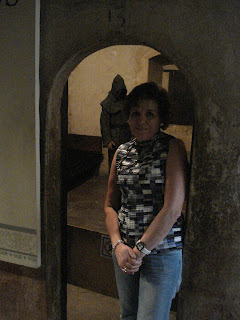Tourists coming to Mexico City usually allow themselves at least a day to travel out of town to visit the marvelous pyramids of Teotihuacan. Only a few minutes before arriving to Teotihuacan, they run past an old Church, clearly visible from the highway, in the town of Acolman, but very few buses bother to stop over and explain how important this mission was in the early history of Mexico, in the years just after the conquest, and the role the Augustinian Order played in this part of the country.
The Franciscans were the first religious congregation to come to Mexico after the Conquest, followed by the Dominicans two years later. Almost 12 years after the Conquest, in 1533, the first Augustinian Missionaries arrived to Mexico. Not only did they start up centers of Evangelization in Mexico City during their first years here in Mexico, but following the suit of the Franciscans and the Dominicans, they started routes of Missions outside the City, mainly to the north and to the west.
In 1539, these first Augustinian Missionaries began a Church and Monastery complex in the City of Acolman. It was finished in 1560.
These first Augustinian Missionaries were very brave. Unlike other missions in Mexico, where the local population was pacific, Acolman was subject during the greater part of the XVI Century to savage Indian attacks. So the enclave of Acolman not only took the aspect of a Monastery, but of an armed fort as well. Notice the stone wall behind by wife's back in the above picture.
Here I am on one of the ramparts, leading away from the huge outside atrium used for catechizing the first native catechumens, and for large Mass celebrations that would be impossible to hold inside the Church. During the following centuries, the baroque stone façade was added to the entrance to the nave of the Church. However, a unique element in this Augustinian Mission, was the balcony up on the second floor, at the right of the entrance. This was obviously used for Passion Plays and many other plays, intended as part of the Augustinians Evangelization effort. This architectural element had been integrated into ecclesiastical architecture as early as the beginning of the XIth Century. A good example can be found is Torcello, in the lagoon of Venice.
Nowadays, many trees have been planted in the atrium, as you can see in this picture. Again notice the height of the wall in the background.
Here I am leaning on a split tree outside the walls of the atrium, with the church steeples in the background. This type of wall of a fortified structure was common in many places in Mexico, and still survives.
Here is a closer view of the balcony in the façade of the Monastery. As I previously stated, the object of this balcony was for passion plays and other religious plays. During Holy Week, they still hold a Passion Play in Acolman, 450 years later. Notice the beautiful fresco/style paintings, in which the native artist used local pigments and technique.
Estela is gazing into the sunset from the balcony.
Here I am on the balcony, amazed not only by the beauty of the frescos, but by the pristine state in which they have been preserved down to our age.
Estela stands outside a cell, where Augustinian monks formerly lived their life of prayer and contemplation.
Here is a part of the Acolman compound that has fallen into ruins, and has never been repaired. However, Estela and I tried to imagine the state of terror in which the first Christian settlers lived here, as they might have gazed from this very same point into the horizon, waiting for an attach from unfriendly natives.
Acolman had two courtyards.
A beautiful fresco of the Crucifixion along one of the aisles of the Cloister.
Estela is sitting on the base of an Atrial Cross, which either served also as a well or as part of the underground cistern.
Here is a view of the ramparts that slowly go down towards the façade of the monastery, and assuredly in previous times served as a sort of amphitheater for enjoying the religious plays up on the balcony.
The stone carving of the façade at Acolman is overwhelming. Not only are the most important saints taken into account, but also the angels.






















































